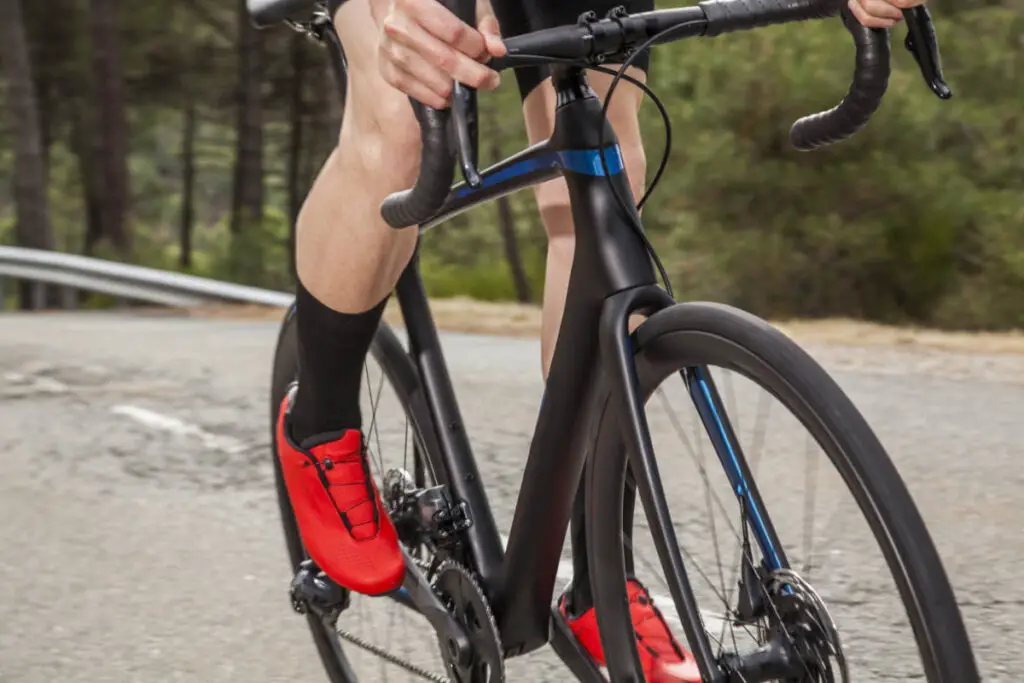There are huge differences between mountain and road bikes for those who appreciate biking and enjoy daily rides.
There are a lot of pros and cons to each, and we will list them so you can see and choose the best option for yourself.
In this article, find out which bike type is right for you through a detailed but short description of each, the pros & cons, and the most significant differences between them.
Advertising links are marked with *. We receive a small commission on sales, nothing changes for you.
What Is A Road Bike?

Road bikes are bicycles made for riding on horizontal surfaces as quickly and as far as you can pedal. The name “road bike” refers to the surface on which it is intended to be used: the road.
Today, road bikes are the same as they were 50 years ago, but more technologically advanced, quicker, and more comfortable than ever.
What Is A Mountain Bike (With Slicks)?
A mountain bike is generally what you want if you want to go “off the road” a lot, which would involve riding into the desert or through the forests on rocky or sandy tracks.
Mountain bikes are made for riding in terrain that is more challenging, and typically:
- Can withstand a lot of stress and damage and yet allow the rider to easily navigate hard terrain and go over or through obstacles that they may find on the trail
- It offers more clearance to travel over rocks, logs, ruts, etc.
The difference between a mountain bike with slicks and a mountain bike without the slicks is the effort you put in when pedaling.
To put it shortly, you will go faster with the same effort you would put into a bike without the slicks. So if you want to be speedier without more sweat, it is time to put the slicks on.
Road Vs. Mountain Bike (With Slicks): Advantages & Disadvantages
Here we will list several pros and cons of both mountain and road bikes.
Road Bike: Pros & Cons
First, let’s see what the advantages are.
- Components are relatively simple to repair;
- They are built for speed since they are incredibly light and maneuverable;
- They feature thin tires and light frames, which decrease friction;
- They provide the best riding position for enhancing leg speed and strength;
- several possibilities at various pricing tiers.
On the other hand, we have disadvantages.
- Less resilient than mountain bikes;
- Challenging to ride slowly due to a high anxiety threshold;
- Unable to be utilized on muddy surfaces;
- It might put stress on the rider’s neck and wrists.
Mountain Bike: Pros & Cons
Now let’s see what is good and not about mountain bikes.
- Strong frames that can withstand normal usage;
- A great deal of traction makes climbing quite simple;
- The ride is much more pleasant;
- Potholes and rocks are no match for wheels.
- Speedier ride because of the slick tires.
And on the other hand…
- Greater resistance to rolling;
- Not as quick as road bikes;
- Heavier than road bikes;
- Significantly more work is needed to ride on paved surfaces;
- They are more effective when a suspension steals the pedal stroke force.
- Slicks are not a good choice if you plan to ride on unpaved surfaces.
What Are The Main Differences Between Mountain Bike With Slicks And A Road Bike?
Now let’s see the most prominent differences between the two bikes: the road and the mountain bike.
To begin with, road bikes need less maintenance overall.
Road cycles often scuff up slower than mountain bikes. This is because they ride on the pavement rather than through dirt and mud.
Consequently, you won’t need to oil and clean the chain as regularly. But on the other hand, mountain bikes need to be cleaned after every ride.
Mountain bikes are less efficient than road bikes.
The most crucial factor in determining efficiency is aerodynamics.
Road bikes have a significant aerodynamic advantage over mountain bikes because of their riding position. You can stoop down to reduce drag due to the frame’s shape and handlebars. By doing this, less effort is needed to pedal against wind resistance.
If you put some slicks on your MTB, you might achieve better aerodynamics, but it still won’t be the same as it is on the road bike.
However, road bike parts are typically a little brittler than mountain bike parts since road bikes are designed with lightweight in mind. Durability is slightly diminished.
Road bike components may be less robust since off-road cycling places less stress on them.
And lastly, road bicycles cost more.
Road bikes are reasonably priced and start at approximately $1200, mountain bikes of comparable quality frequently cost $200–400 less on average.
To conclude, both bikes are excellent choices. Which one is your favorite?

Hi dear visitor! I’m Sebastian, a bike maniac who loves to spend a lot of time on two wheels in nature (I love white chocolate, so I absolutely need a calorie-burning balance that’s fun to boot ). Blogging is my second great passion. That’s why cyclinghalloffame.com regularly features new bike-related content.
Advertising links are marked with *. We receive a small commission on sales, nothing changes for you.

